Assessing Central Bank Credibility in Emerging Markets

Monetary policy in emerging markets (EMs) underwent drastic change at the beginning of the 21st century. Following the Asian (1997) and Russian (1998) financial crises, many central banks in EMs stopped targeting exchange rates and adopted an inflation targeting framework. Broadly speaking, that switch has been successful at reducing inflation and bolstering central banks’ credibility.
But the recent acceleration and persistence of inflation in many EMs raises new challenges for central bankers and investors. In our view, the current high inflation is the result of (mostly) exogenous shocks but also of domestic polices, like a slow retrenchment of pandemic-era fiscal expansion.
The recent rise in inflation might, then, put these central banks’ hard-earned credibility at risk. In this note, we look at the experience of five major EM central banks that have adopted an inflation-target framework (table 1).
Table 1: Inflation Targets of Select EM Central Banks

Source: IMF, as of April 2023.
Anchoring inflation expectations is a key component of the inflation target framework. When expectations are de-anchored, the risk of runaway inflation increases. This, in turn, might require stricter monetary tightening than if the central bank had acted earlier. For that reason, anchoring expectations when inflation surges is an important pre-emptive action for central banks that have adopted an inflation-targeting framework.
To analyze the behavior of the five central banks in our sample, we first assess how successful they have been in anchoring inflation expectations. We do so by computing a simple “credibility index”, as described in the Appendix. That index is a normalized measure of the difference between inflation expectations and the central bank’s inflation target, where 1 = full credibility of the target.
Table 2: Summary Statistics on Inflation, Inflation Expectations and Central Bank Credibility
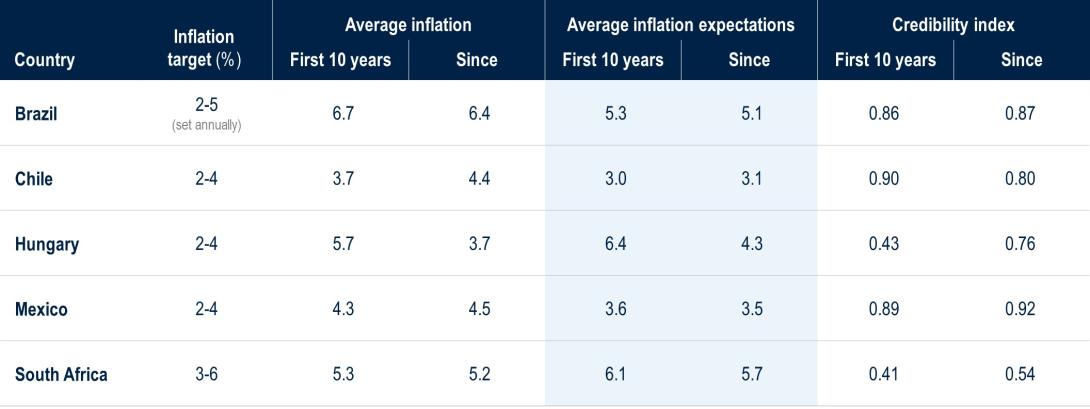
Source: PGIM Fixed Income, Haver, as of April 2023.
Table 2 shows that inflation expectations generally converge towards the inflation target even when actual inflation is outside of the target band. Hungary and Brazil are the only countries where average inflation expectations remain above target – albeit slightly – even after our arbitrarily-imposed 10 year “credibility building” period.
Second, we look at descriptive statistics to find regularities in central banks’ policies and outcomes.
Figures 1 to 5 show that, all else equal, the faster and more determined a central bank is in rising rates, the faster inflation expectations drop.
A single large hike may not be enough (as in Hungary’s recent experience) and other sizeable hikes may be needed (as in Chile and Mexico) to lower inflation expectations. Once inflation expectations are anchored within the target band, prudent rate cuts can follow (Chile currently, Chile and South Africa in 2008, Brazil in 2002).
Figures 1-5: Changes in Inflation Expectations and Policy Responses
Figure 1: Brazil - Policy Rate Response
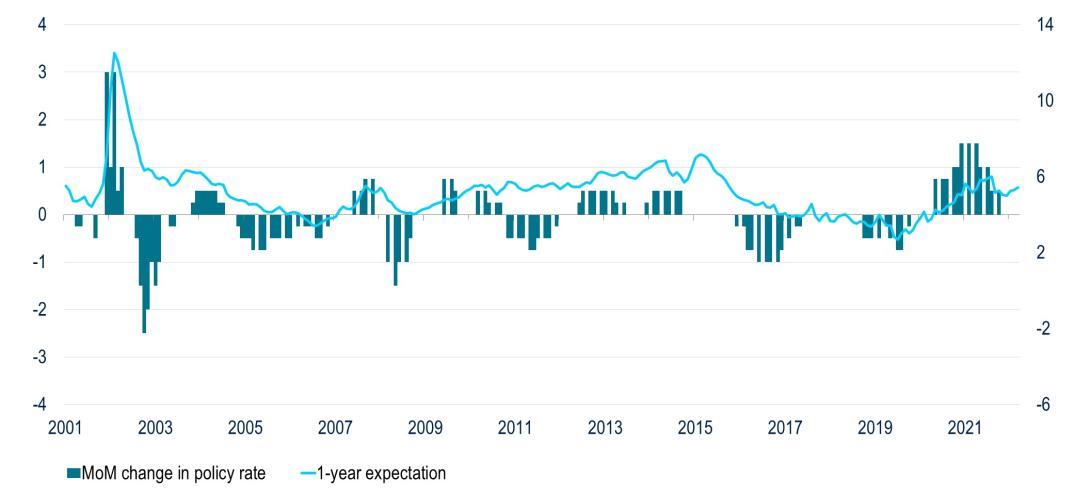
Source: PGIM Fixed Income, Haver, as of April 2023.
Figure 2: Chile - Policy Rate Response
 Source: PGIM Fixed Income, Haver, as of April 2023.
Source: PGIM Fixed Income, Haver, as of April 2023.
Figure 3: Hungary - Policy Rate Response
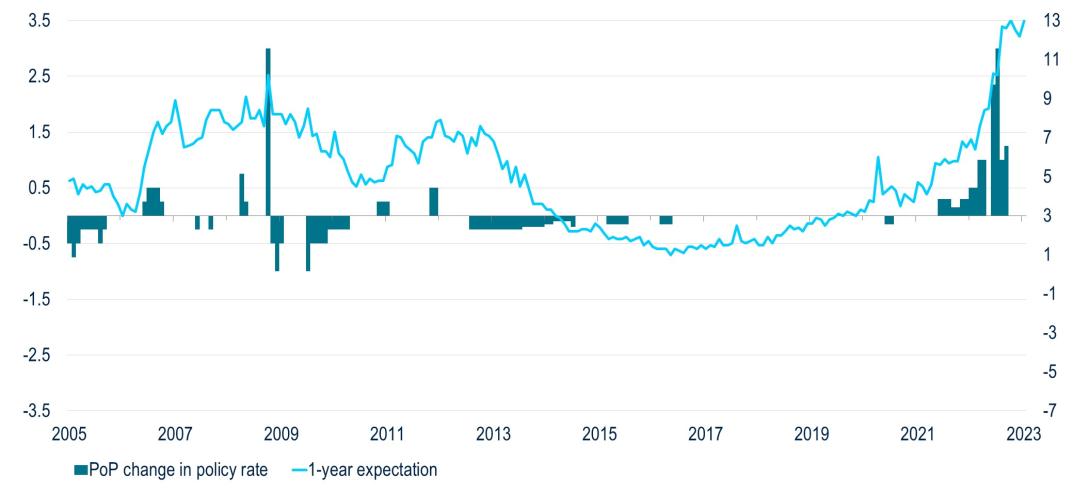
Source: PGIM Fixed Income, Haver, as of April 2023.
Figure 4: Mexico - Policy Rate Response
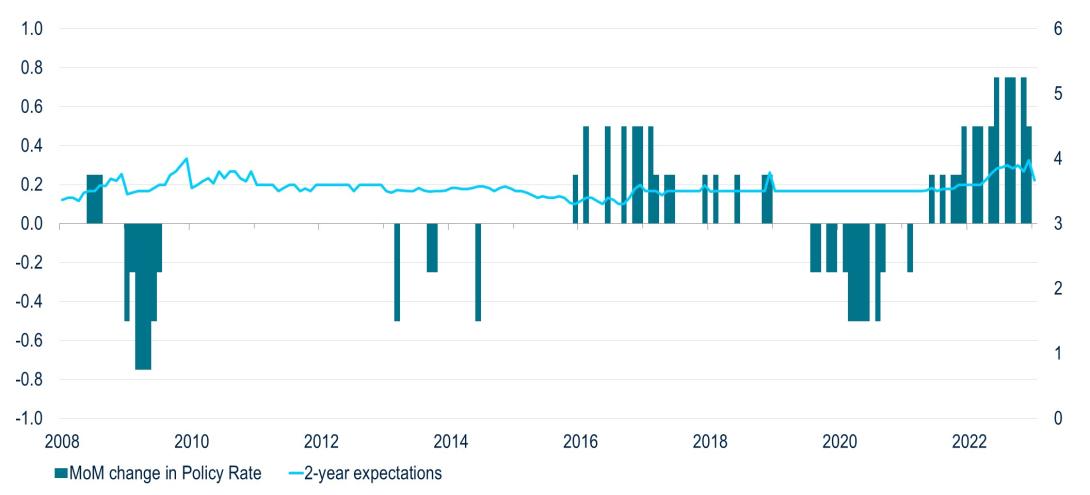
Source: PGIM Fixed Income, Haver, as of April 2023.
Figure 5: South Africa - Policy Rate Response
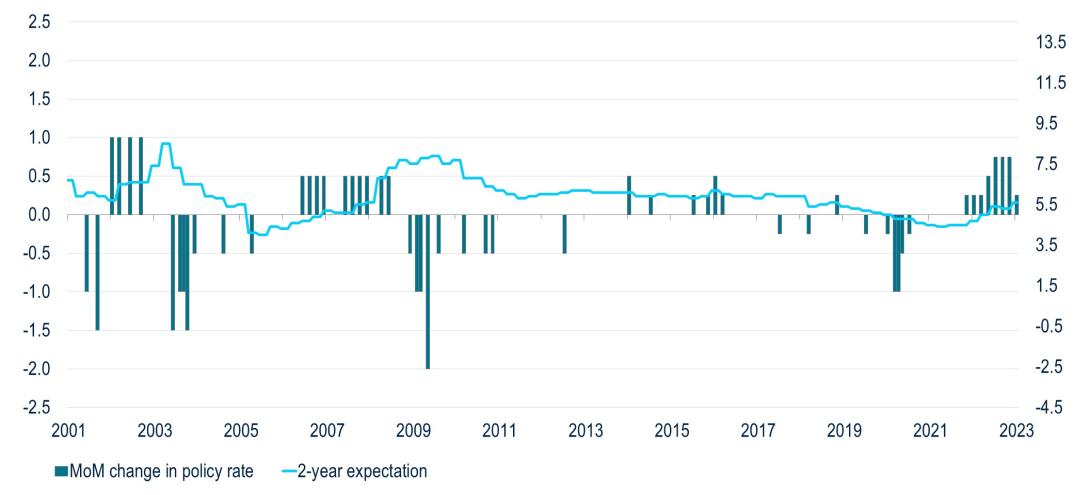
Source: PGIM Fixed Income, Haver, as of April 2023.
These findings have important investment implications. The countries in our sample are a varied bunch: they differ in fiscal policy, output gaps, capital flows, central bank independence, ex-ante real interest rates etc. But all else equal, we find that central banks that hike first and more significantly appear to gain benefits in terms of credibility. As a result, they are likely to cut policy rates first. Investors in local-currency bond markets should therefore closely monitor the speed with which central banks respond when inflation accelerates.
APPENDIX: Our central bank credibility index
For each survey, we calculate the difference between 1-year inflation expectations (or 2-year expectations, depending on the inflation target set by the respective central bank) and the central bank’s inflation target. Since these countries have a target band, we calculate the difference between expectations and the mid-value of that band. We then normalize that time series of differences to fall between 0 and 1, using the normalization formula. The index at time “t” then becomes1:
Index(t) = 1- dP(t)/{max[Ex(0…T) – P*] – min[Ep(0…T) – P*]}
Where:
P* = inflation target
Ep(t) = expected inflation at time “t”
dP(t) = Ep(t) -P*
0FIGURE A.1: South Africa - Central Bank Credibility Index Source: PGIM.
Source: PGIM.
1 If inflation expectations fall below the target, we assign a value of zero (i.e., target met) to that observation.
Read More From PGIM Fixed Income
The comments, opinions, and estimates contained herein are based on and/or derived from publicly available information from sources that PGIM Fixed Income believes to be reliable. We do not guarantee the accuracy of such sources or information. This outlook, which is for informational purposes only, sets forth our views as of this date. The underlying assumptions and our views are subject to change. Past performance is not a guarantee or a reliable indicator of future results.
Source(s) of data (unless otherwise noted): PGIM Fixed Income, as of May 17, 2023.
For Professional Investors only. Past performance is not a guarantee or a reliable indicator of future results and an investment could lose value. All investments involve risk, including the possible loss of capital.
PGIM Fixed Income operates primarily through PGIM, Inc., a registered investment adviser under the U.S. Investment Advisers Act of 1940, as amended, and a Prudential Financial, Inc. (“PFI”) company. Registration as a registered investment adviser does not imply a certain level or skill or training. PGIM Fixed Income is headquartered in Newark, New Jersey and also includes the following businesses globally: (i) the public fixed income unit within PGIM Limited, located in London; (ii) PGIM Netherlands B.V., located in Amsterdam; (iii) PGIM Japan Co., Ltd. (“PGIM Japan”), located in Tokyo; (iv) the public fixed income unit within PGIM (Hong Kong) Ltd. located in Hong Kong; and (v) the public fixed income unit within PGIM (Singapore) Pte. Ltd., located in Singapore (“PGIM Singapore”). PFI of the United States is not affiliated in any manner with Prudential plc, incorporated in the United Kingdom or with Prudential Assurance Company, a subsidiary of M&G plc, incorporated in the United Kingdom. Prudential, PGIM, their respective logos, and the Rock symbol are service marks of PFI and its related entities, registered in many jurisdictions worldwide.
These materials are for informational or educational purposes only. The information is not intended as investment advice and is not a recommendation about managing or investing assets. In providing these materials, PGIM is not acting as your fiduciary. PGIM Fixed Income as a general matter provides services to qualified institutions, financial intermediaries and institutional investors. Investors seeking information regarding their particular investment needs should contact their own financial professional.
These materials represent the views and opinions of the author(s) regarding the economic conditions, asset classes, securities, issuers or financial instruments referenced herein. Distribution of this information to any person other than the person to whom it was originally delivered and to such person’s advisers is unauthorized, and any reproduction of these materials, in whole or in part, or the divulgence of any of the contents hereof, without prior consent of PGIM Fixed Income is prohibited. Certain information contained herein has been obtained from sources that PGIM Fixed Income believes to be reliable as of the date presented; however, PGIM Fixed Income cannot guarantee the accuracy of such information, assure its completeness, or warrant such information will not be changed. The information contained herein is current as of the date of issuance (or such earlier date as referenced herein) and is subject to change without notice. PGIM Fixed Income has no obligation to update any or all of such information; nor do we make any express or implied warranties or representations as to the completeness or accuracy.
Any forecasts, estimates and certain information contained herein are based upon proprietary research and should not be interpreted as investment advice, as an offer or solicitation, nor as the purchase or sale of any financial instrument. Forecasts and estimates have certain inherent limitations, and unlike an actual performance record, do not reflect actual trading, liquidity constraints, fee. These materials are not intended as an offer or solicitation with respect to the purchase or sale of any security or other financial instrument or any investment management services and should not be used as the basis for any investment decision. PGIM Fixed Income and its affiliates may make investment decisions that are inconsistent with the recommendations or views expressed herein, including for proprietary accounts of PGIM Fixed Income or its affiliates.
Investing in the bond market is subject to risks, including market, interest rate, issuer, credit, inflation risk, and liquidity risk. The value of most bonds and bond strategies are impacted by changes in interest rates. Bonds and bond strategies with longer durations tend to be more sensitive and volatile than those with shorter durations; bond prices generally fall as interest rates rise, and low interest rate environments increase this risk. Reductions in bond counterparty capacity may contribute to decreased market liquidity and increased price volatility. Bond investments may be worth more or less than the original cost when redeemed. Mortgage- and asset-backed securities may be sensitive to changes in interest rates, subject to early repayment risk, and while generally supported by a government, government agency or private guarantor, there is no assurance that the guarantor will meet its obligations. High yield, lower-rated securities involve greater risk than higher-rated securities; portfolios that invest in them may be subject to greater levels of credit and liquidity risk than portfolios that do not. Investing in foreign-denominated and/or -domiciled securities may involve heightened risk due to currency fluctuations, and economic and political risks, which may be enhanced in emerging markets. Currency rates may fluctuate significantly over short periods of time and may reduce the returns of a portfolio. Commodities contain heightened risk, including market, political, regulatory and natural conditions, and may not be suitable for all investors. Diversification does not ensure against loss.
In the United Kingdom, information is issued by PGIM Limited with registered office: Grand Buildings, 1-3 Strand, Trafalgar Square, London, WC2N 5HR. PGIM Limited is authorised and regulated by the Financial Conduct Authority (“FCA”) of the United Kingdom (Firm Reference Number 193418). In the European Economic Area (“EEA”), information is issued by PGIM Netherlands B.V., an entity authorised by the Autoriteit Financiële Markten (“AFM”) in the Netherlands and operating on the basis of a European passport. In certain EEA countries, information is, where permitted, presented by PGIM Limited in reliance of provisions, exemptions or licenses available to PGIM Limited under temporary permission arrangements following the exit of the United Kingdom from the European Union. These materials are issued by PGIM Limited and/or PGIM Netherlands B.V. to persons who are professional clients as defined under the rules of the FCA and/or to persons who are professional clients as defined in the relevant local implementation of Directive 2014/65/EU (MiFID II). In certain countries in Asia-Pacific, information is presented by PGIM (Singapore) Pte. Ltd., a Singapore investment manager registered with and licensed by the Monetary Authority of Singapore. In Japan, information is presented by PGIM Japan Co. Ltd., registered investment adviser with the Japanese Financial Services Agency. In South Korea, information is presented by PGIM, Inc., which is licensed to provide discretionary investment management services directly to South Korean investors. In Hong Kong, information is provided by PGIM (Hong Kong) Limited, a regulated entity with the Securities & Futures Commission in Hong Kong to professional investors as defined in Section 1 of Part 1 of Schedule 1 (paragraph (a) to (i) of the Securities and Futures Ordinance (Cap.571). In Australia, this information is presented by PGIM (Australia) Pty Ltd (“PGIM Australia”) for the general information of its “wholesale” customers (as defined in the Corporations Act 2001). PGIM Australia is a representative of PGIM Limited, which is exempt from the requirement to hold an Australian Financial Services License under the Australian Corporations Act 2001 in respect of financial services. PGIM Limited is exempt by virtue of its regulation by the FCA (Reg: 193418) under the laws of the United Kingdom and the application of ASIC Class Order 03/1099. The laws of the United Kingdom differ from Australian laws. In Canada, pursuant to the international adviser registration exemption in National Instrument 31-103, PGIM, Inc. is informing you that: (1) PGIM, Inc. is not registered in Canada and is advising you in reliance upon an exemption from the adviser registration requirement under National Instrument 31-103; (2) PGIM, Inc.’s jurisdiction of residence is New Jersey, U.S.A.; (3) there may be difficulty enforcing legal rights against PGIM, Inc. because it is resident outside of Canada and all or substantially all of its assets may be situated outside of Canada; and (4) the name and address of the agent for service of process of PGIM, Inc. in the applicable Provinces of Canada are as follows: in Québec: Borden Ladner Gervais LLP, 1000 de La Gauchetière Street West, Suite 900 Montréal, QC H3B 5H4; in British Columbia: Borden Ladner Gervais LLP, 1200 Waterfront Centre, 200 Burrard Street, Vancouver, BC V7X 1T2; in Ontario: Borden Ladner Gervais LLP, 22 Adelaide Street West, Suite 3400, Toronto, ON M5H 4E3; in Nova Scotia: Cox & Palmer, Q.C., 1100 Purdy’s Wharf Tower One, 1959 Upper Water Street, P.O. Box 2380 - Stn Central RPO, Halifax, NS B3J 3E5; in Alberta: Borden Ladner Gervais LLP, 530 Third Avenue S.W., Calgary, AB T2P R3.
© 2023 PFI and its related entities.
2023-4067
Sign Up Now for Full Access to Articles and Podcasts!
Unlock full access to our vast content library by registering as an institutional investor .
Create an accountAlready have an account ? Sign in
